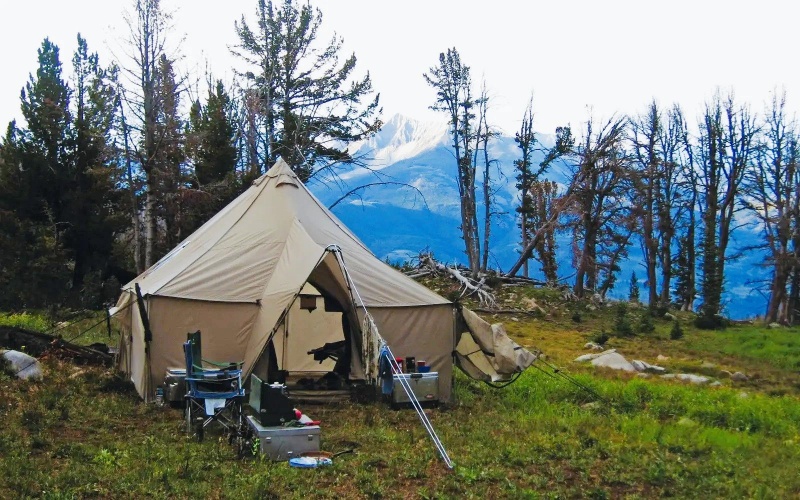Living in a Canvas Tent Long Term
Thinking about living in a canvas tent long-term? Whether it’s a desire to embrace nature, establish yourself on a new plot of land, or escape the rising costs of traditional housing, tent life offers a unique and rewarding experience.
Just as there are many ways to approach life, there are many ways to live in a canvas tent. Some people prioritize modern conveniences like electricity, while others prefer a minimalist lifestyle. Your motivations for long-term tent living will significantly shape your priorities, essential supplies, and overall experience.
To help answer common questions and provide practical insights, we’ve gathered advice from experienced tent dwellers—woodsmen, adventurous couples, and families adapting to off-grid life. Their firsthand experiences reveal both the rewards and the challenges of tent living, ensuring you can prepare effectively.
Three key factors will determine what you need to make your tent feel like home:
Location – Your environment affects comfort, protection, and maintenance needs.
Infrastructure – A strong setup ensures safety, durability, and usability.
Budget & Essentials – Prioritizing necessities prevents unnecessary expenses.
While this may sound simple, each factor involves careful planning. Below, we dive into each in detail, incorporating real-life lessons from seasoned tent dwellers.
Canvas tents are versatile, but your chosen environment plays a crucial role in ensuring long-term comfort and durability.
A canvas tent must withstand varying weather conditions. In wet climates, a rainfly or additional covering is essential. In cold regions, heating solutions like wood stoves are necessary, while in hot climates, ventilation and shade are critical.
For example, Matt and Lily moved to the English countryside with their daughter and faced unexpected challenges. Poor furniture placement led to water seepage, and strong winds nearly toppled their wood stove before they secured it with screws. According to Lily, adaptability is key: “You definitely need a sense of humor. You can't be vain—you’ll get upset over mud or the lack of running water.”
Living outdoors means sharing space with nature. When David Schilling spent three years in a 12x14 canvas wall tent in rural Virginia, he quickly discovered that uninvited guests—like mice—would raid his food. His solution? Regular pest control, secure food storage, and setting traps.

A long-term tent setup requires a solid foundation. Choose a location with proper drainage, away from falling tree branches, and close to toilet facilities. Many experienced tent dwellers build a wooden platform to create a stable base and prevent moisture buildup.
Jacob and Keesha from Wild Ridge Homestead documented their three-day canvas tent setup, including a sturdy wooden deck. Similarly, Life Intents offers detailed bell tent deck plans, including porches, stairs, and secure footings.
Access to clean water and electricity varies based on location and budget. Some opt for off-grid solutions like rainwater collection and solar panels, while others adapt to minimal usage.
David chose a no-electricity lifestyle, relying on battery-powered devices, candles, and a propane stove. Meanwhile, Jojo and Norah from Sweden implemented an advanced solar setup to power their floating tent raft. If you require electricity, a generator or solar-powered battery pack is a practical solution.
In a tent, kitchens are compact and multifunctional. Many rely on wood stoves for both cooking and heating, while others use propane burners.
Matt and Lily initially struggled with cooking times, stating: “We sat there for three hours wondering why things wouldn’t boil.” They eventually learned to adapt with slow-cooking recipes using their wood stove.
For those wanting more, outdoor camp kitchens can provide a full cooking setup, including a stove, oven, and sink. Cupcake and Cornbread’s kitchen tour showcases just how sophisticated off-grid kitchens can be.
Bathroom facilities vary based on location and infrastructure. Options include:
Outbuildings – Using existing structures or building a simple outhouse.
Portable Camping Toilets – Common in off-grid setups, often paired with a composting system.
Natural Solutions – Some tent dwellers prefer earthen toilets or even using the surrounding forest.
Matt and Lily had access to a separate bathroom building, while David and others relied on eco-friendly composting toilets with pinewood chips to minimize odor.
Heating: Wood stove, propane heater, or thermal insulation.
Cooling: Proper ventilation, shade, and airflow solutions.
Humidity Management: Dehumidifiers or moisture absorbers.
Reliable water source (filtration system or collection setup).
Off-grid food storage (coolers, preservation methods like pickling).
Animal-proof containers for pest control.
Waterproofing treatments for the tent fabric.
Basic repair supplies (duct tape, extra poles, spare stakes).
Pest deterrents and security measures.
Bathing setup (solar shower, sponge baths, or shared facilities).
Sanitation supplies (toilet solutions, waste disposal plans).
Backup power source (solar generator, battery bank).
First aid kit and emergency supplies.
Shelter alternatives for extreme weather conditions.
Living in a canvas tent offers a unique blend of simplicity, self-sufficiency, and adventure. The key to a successful experience lies in preparation and adaptability. Whether you choose a minimalist approach or incorporate modern conveniences, planning for climate control, food and water access, maintenance, and safety will ensure a comfortable and rewarding off-grid lifestyle.